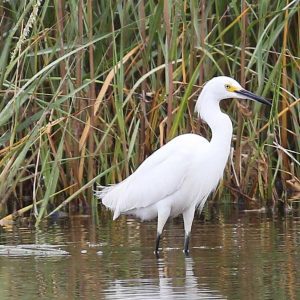
Wharton Point, Maquoit Bay, Brunswick, by Beth Comeau
A few weeks ago, while in the area, we took the opportunity to check out the birding at Wharton Point in Brunswick. We pulled into the little parking area that overlooks Maquoit Bay and quickly noticed the tide was just off high tide—perfect for shorebirding, as they would all be feeding in the constrained area between the water’s edge and the land.
A few weeks later, we were amazed that our great birding luck at Wharton Point continued. We were again in the area, running in and around Brunswick and, on a whim, decided to stop off at Wharton Point on our way to our last errand.
We arrived as the tide was going out, revealing more and more of the extensive mudflats at the base of the parking area and shrub-covered hillside. Just like before, there was an incredible abundance of birds taking advantage of the food that the bay provides.

Among a slew of shorebirds the author’s saw recently at Wharton Point, a lone Pectoral Sandpiper. Photo courtesy of Wiki Commons.
To our delight, we soon found that many of the same species were in attendance. There were Black-bellied Plovers, though a smaller flock. Greater Yellowlegs, too, but no Lesser Yellowlegs, as we had seen previously—they usually disappear from the Maine coast before the Greaters do (a few of which sometimes persist into the winter).
We even noted one shorebird surprise: A Pectoral Sandpiper that we hadn’t noticed until an immature Northern Harrier, with its richly cinnamon breast and underwings, floated low over the shore, spooking all of the shorebirds into flight. We could hear the plaintive calls of the plovers but also a low “churk.” The 29 Black-bellied Plovers (yes, we counted them) amassed into a tight-flying flock and circled around a few times before alighting on the mudflats again. As they landed, we noticed one smaller bird among them, a Pectoral Sandpiper, the source of that other call. With the aid of our telescope, we could see the distinctive, sharply delineated breast-streaking even at a distance.

Snowy Egret, by David Small
Egrets and herons were there again as well, only this time more scattered and distant. There were Great Egrets and Snowy Egrets and Great Blue Herons up and down the shore.

A Palm Warbler, one of the late-returning migrant warbler species, hopped around in the brushy area near the parking lot as the Wharton Point. Photo by Jeff Wells.
The terns were all gone now (could some of them be in South America already?) but the Ring-billed Gulls still packed into that spot in the hundreds. They really like it there! We mused on whether many of them were from breeding colonies up in the St. Lawrence River near Montreal.
Two species of late-arrival migrant warblers popped up in the bushes there near the parking lot at Wharton Point: a Palm Warbler showed off its yellow undersides as it pumped its tail up and down in the characteristic way that they do. Minutes later we heard a distinctive “chuck” and a Yellow-rumped Warbler landed in the same tree.
The bird show probably continued but it did so without us. Our last errand needed tending to so off we went, but we left feeling refreshed and blessed.
—Allison & Jeff Wells












Hi Allison and Jeffery,
Enjoyed your great finds at Maquoit Bay, such a great spot and so close.
Thanks for your great reporting.
Hope to see you at our wonderful walking spot sometime.
Glad you enjoyed it, Paula. Thanks for letting us know!
Allison and Jeff
I hope I run into you sometime while I am out birding.
TLW
Perhaps so!
Good birding,
Jeff and Allison